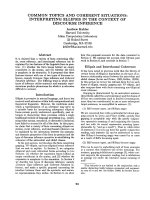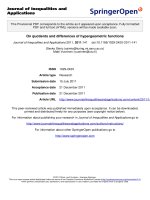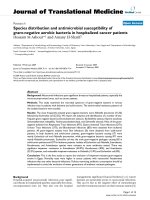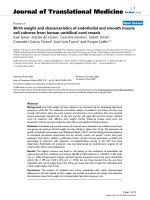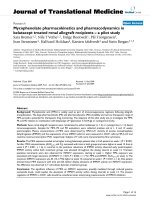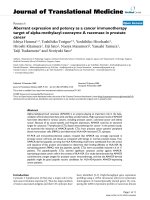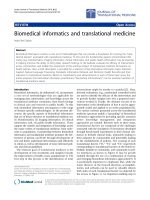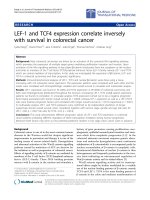báo cáo hóa học: " Struggles, strengths, and strategies: an ethnographic study exploring the experiences of adolescents living with an ostomy" doc
Bạn đang xem bản rút gọn của tài liệu. Xem và tải ngay bản đầy đủ của tài liệu tại đây (235.68 KB, 8 trang )
BioMed Central
Page 1 of 8
(page number not for citation purposes)
Health and Quality of Life Outcomes
Open Access
Research
Struggles, strengths, and strategies: an ethnographic study
exploring the experiences of adolescents living with an ostomy
David B Nicholas*
1,2
, Sylvia R Swan
2
, Ted J Gerstle
3
, Theresa Allan
4
and
Anne Marie Griffiths
5
Address:
1
Faculty of Social Work, Central and Northern Region, University of Calgary, #444, 11044-82 Avenue, Edmonton, Alberta, Canada,
2
Department of Social Work, Hospital for Sick Children, 555 University Ave, Toronto, ON M5G 1X8, Canada,
3
Department of General Surgery,
Hospital for Sick Children, 555 University Ave, Toronto, ON M5G 1X8, Canada,
4
5B Ward – Long Stay Surgical Unit, Hospital for Sick Children,
555 University Ave, Toronto, ON M5G 1X8, Canada and
5
Gastroenterology, Hepatology and Nutrition, Hospital for Sick Children, 555 University
Ave, Toronto, ON M5G 1X8, Canada
Email: David B Nicholas* - ; Sylvia R Swan - ; Ted J Gerstle - ;
Theresa Allan - ; Anne Marie Griffiths -
* Corresponding author
Abstract
Background: Adolescents with IBD requiring ostomy surgery experience perioperative needs
that may exceed those of patients experiencing other major abdominal surgery [1]. This procedure
requires ongoing and vigilant daily care and management. Gastrointestinal symptoms and
complications impose psychological and social stresses on young patients [2], and the procedure
results in body image changes and daily regimens of self-care. This study aimed to explore
adolescents' experiences and quality of life following ostomy surgery.
Methods: Ethnographic interviews and a subsequent focus group were conducted with 20
adolescents with an ostomy or j-pouch being treated at the Hospital for Sick Children in Toronto,
Canada. Interviews were transcribed verbatim and subjected to theme generation.
Results: Findings suggest that adolescents are profoundly affected by their ostomy. Adolescents
convey strength as well as adjustment struggles. Identified impacts include body intrusion and body
image changes, decreased independence, secrecy about the ostomy, adjustment over time,
challenges for the family, and strategies for constructively moving forward.
Conclusion: Implications address the importance of ensuring meaningful opportunities to
understand and reframe the stresses of illness. An ongoing clinical challenge involves the promotion
of a healthy self-esteem and psychosocial adjustment for these adolescents and their families.
Finding effective ways to minimize stress and embarrassment and reframe personal shame,
constitute important clinical priorities. Opportunities for peer support and family dialogue may
assist in clarifying worries and easing the burden carried by these young persons. Flexible and
adequately funded resources are advocated in fostering quality of life.
Published: 17 December 2008
Health and Quality of Life Outcomes 2008, 6:114 doi:10.1186/1477-7525-6-114
Received: 28 May 2008
Accepted: 17 December 2008
This article is available from: />© 2008 Nicholas et al; licensee BioMed Central Ltd.
This is an Open Access article distributed under the terms of the Creative Commons Attribution License ( />),
which permits unrestricted use, distribution, and reproduction in any medium, provided the original work is properly cited.
Health and Quality of Life Outcomes 2008, 6:114 />Page 2 of 8
(page number not for citation purposes)
Background
The incidence of inflammatory bowel disease (IBD) varies
globally, and ranges from 0.3% to 0.8% of the population
in northern Europe, Scandinavia, New Zealand and the
United States [3]. IBD is reported to manifest during
childhood or adolescence in 20–25% of patients [2,4].
Canadian data estimates that 12% of individuals in the
17–24 year age group with ulcerative colitis require sur-
gery [5], and approximately 26% of children with moder-
ate to severe ulcerative colitis require surgery within 5
years of diagnosis because of treatment failure or an ina-
bility to control symptoms [6,7]. An ostomy, also com-
monly called a stoma, is a surgically created opening
through which a portion of the small or large intestine is
exteriorized for the diversion of fecal matter outside the
body [8]. In some cases, the ostomy eventually will be
closed and a surgically-created reservoir called a j-pouch
will be created from the small intestine. Adolescents with
IBD who require ostomy surgery experience perioperative
needs that may exceed that of patients experiencing other
major abdominal surgery [1]. This procedure requires
ongoing and vigilant daily care and management. Gas-
trointestinal symptoms and complications impose psy-
chological and social stresses on young patients [2], and
the procedure results in body image changes and daily
regimens of self-care.
This interpretive study examined adolescents' experiences
following ostomy surgery. An ethnographic approach,
using interviews and a focus group, was used to identify
impacts of the ostomy including challenges, resources and
adaptational strategies.
Relatively little is known about the psychosocial adjust-
ment of young patients with IBD [9]. Clinical experience
and exploratory research suggest that this population is at
emotional risk due to body image issues, periodic illness
exacerbation, complications, daily care requirements,
uncertainties, developmental concerns, and stigma [10].
IBD patients who undergo ostomy surgery experience fur-
ther psychosocial obstacles as surgery exceeds the
demands and challenges typically faced by individuals
with IBD[10]. Several studies with small sample sizes sug-
gest that these adolescents experience substantial post-
surgical challenges with respect to diminished self esteem,
peer socialization, social stigma, sexual identity, inde-
pendence, body image shifts, embarrassment, grief, and
loss of control [1,11-15]. Post-surgical adolescent ostomy
patients are further reported to identify self-repulsion
when initially viewing their stoma [11].
Ostomy surgery often occurs during adolescence, a time in
human development when peer acceptance and body
image issues may be particularly heightened [1,11,12,15].
Several studies particularly identify body image concerns
among these adolescents such as insecurities about
height, weight and personal appearance [2,14,15]. Strate-
gies for improving the psychosocial wellbeing of adoles-
cents with an ostomy have been offered in the literature.
Erwin-Toth [15] interviewed adults who had undergone
ostomy surgery between the ages of 6 and 12 years.
Informants retrospectively described negative impacts on
their lives during adolescence and recommended peer
contact with other adolescents experiencing an ostomy as
a means for managing stress. Adolescents are reported to
counteract the challenges of living with an ostomy
through self-management, social support, a positive atti-
tude, and increased control over their own care [16].
Peer support is reported to be a positive moderator of cop-
ing among adolescents. Moreover, supportive and accessi-
ble resources are a priority; however, exploratory research
is yet needed to examine key issues and needs of these
young ostomy patients. While limited exploratory evi-
dence exists, current studies are limited in volume and
methodological rigor. Clinical evidence is largely drawn
from anecdotal accounts and often comprises mixed sam-
ples of children and adolescents. To address this gap and
specifically explore the experiences of youth, this qualita-
tive study examined post-ostomy experiences of adoles-
cents. Specifically, the study sought the illumination of
perceptions, challenges, resources, and adaptational strat-
egies of adolescents who had undergone ostomy surgery.
Methods
This exploratory ethnographic study, as part of a larger
intervention-based project, incorporated qualitative inter-
views and a follow-up focus group. Ethnography is a well-
established qualitative approach that effectively explores
the lived experience of a population [17,18]. Ethnography
invites the identification of daily processes, routines,
events and perspectives from the vantage point of partici-
pants. It is characterized by prolonged engagement and
open discussion within a population, yielding rich
description reminiscent of the population and area under
study. Interviews and focus groups are commonly used
within this research approach. Accordingly, the face-to-
face interviews used in this study offered in-depth narra-
tive detail, and the focus group data added triangulation,
corroboration, elaboration and clarification [19]. This
focus group offered notable data yield because peer inter-
action appeared to be highly valued by participants. They
openly shared and disclosed common experiences. Inter-
views and the focus group were semi-structured, using an
interview schedule in which open-ended questions
guided the interviewing process. The interview guide
reflected existing literature and team members' clinical
experience in pediatric ostomy nursing, social work, med-
icine and surgery. Interviews lasted approximately one
hour, and the focus group was 1.5 hours. They were audio
Health and Quality of Life Outcomes 2008, 6:114 />Page 3 of 8
(page number not for citation purposes)
recorded and transcribed verbatim. Written consent was
obtained from all participants. Ethics approval was
obtained from the Research Ethics Board at the Hospital
for Sick Children prior to study commencement.
Data Analysis
Transcripts were subjected to content analysis, which
comprised (i) line-by-line review of codes within tran-
scripts, (ii) analysis of similarity and difference within
transcript codes, (iii) organization of codes in the devel-
opment of categorization schemes, and (iv) solidification
of themes through review of codes relative to transcripts
[20]. Computer software for qualitative data analysis was
utilized to assist with code identification, category devel-
opment, and theme generation. Trustworthiness of
emerging themes was ensured through established means
of demonstrating referential rigor, including adequacy,
negative case analysis, and peer debriefing [21]. Educative
authenticity, an emerging criterion of qualitative research
rigor, refers to direct educational benefits to participants
following study involvement [22]. This outcome was
achieved through the contribution of data in the ultimate
development of a participant-based teaching booklet for
newly diagnosed adolescents facing ostomy surgery. Ver-
batim text quotes, including those presented herein, may
also appear in this educational resource targeted to ado-
lescent ostomy patients.
The Sample
Participants were recruited from a database of adolescents
with an ostomy who had participated in a support inter-
vention offered at a large pediatric hospital in central Can-
ada. A total of twenty adolescents were interviewed, and
all were subsequently invited to a follow-up focus group,
of which seven were able to attend. Eleven females and
nine males participated in the study, and participants
were culturally diverse, geographically scattered from
both urban and rural home locations, and they ranged in
terms of represented family constellation. The mean age
of participants was 15.3 years, and participants ranged
from 13 to 19 years of age. Mean time since surgery was
2.9 years with a range of three months to ten years; and
participants had an ostomy or j-pouch.
Results and Discussion
Participants conveyed common experiences and impacts
related to their IBD and ostomy. They repeatedly stated
that their daily lives had been dramatically altered, and
the ostomy had introduced struggles as well as elements
promoting personal growth and maturity. Identified
themes comprise body intrusion and body image
changes, decreased independence, secrecy about the
ostomy, adjustment over time, challenges for the family,
and strategies in constructively 'moving forward'. Each of
these identified themes is explored below.
Body Intrusion and Body Image Challenges
Adolescents identified self-consciousness regarding body
image changes and the intrusion upon personal body
space. Difficulties adjusting to body changes were
described. A participant reminisced about pre- and post-
surgery adjustments associated with stoma by stating: "I
just wanted to close my eyes, then open them and 'hey
it's done' It was this massive swollen thing. I was grossed
out by it. But I eventually got used to looking at it." While
body image was of concern to participants, they increas-
ingly became accustomed to, and less repelled by, the
appearance of the stoma.
Adolescents described intrusion of their 'personal space'
and bodies due to frequent health examinations and med-
ical procedures. An adolescent consequently described
frustration and remarked, " so many people in the hos-
pital touched me when I didn't want to be touched. Like
the doctors poked me on my stomach". The participants
identified self-consciousness and worry that others would
notice their ostomy; a concern that they described as
embarrassing and, in some cases, humiliating. One ado-
lescent stated, "At first I was so self-conscious of it If I
needed to empty it or something, I thought, 'oh my God,
people are staring at me'." Adolescents worried that peers
would become aware of the ostomy, as exemplified
below.
"When we dance now, I have a problem with that.
It's so wrong, it's so weird. I'm just so afraid because
it's kind of 'feelable', like the plastic ring. So I'm just
afraid that someone is going to feel it and say 'what is
that?'."
" one of my friends went like this to my stomach
and one of (her) fingers was right on it. I cried when I
went home from school for so long because in my
head I was like 'oh my God, (she) felt it "
Decreased Independence and Control
Upon becoming ill, participants were subjected to
increased levels of personal care and involvement by par-
ents. Participants' independence, a coveted element in
adolescence, decreased as they physically needed a par-
ent's help. In some cases, parents' heightened concern for
the adolescent's well-being incited increased parental
scrutiny toward, and intimate care of, the youth, as illus-
trated below.
"My parent was constantly on me. My advice to a teen
about having the operation is to expect your parent or
parents to basically be overprotective more than they
usually are, because they will be. And for me, my
Health and Quality of Life Outcomes 2008, 6:114 />Page 4 of 8
(page number not for citation purposes)
mom grew out of it I think my mom was just really,
really worried about me to begin with, and whether I'd
be able to deal with it. If I'd be okay. If I'd still be as
sick, because I was really sick before I had the ostomy.
After my mom saw that I could deal with it, it basically
became 'okay, the teen can deal with it. I don't need to
help the teen anymore'."
"Right away my mom was so protective of me and she
was always worried about stuff. Whether I was drink-
ing enough, because you can get so dehydrated I
think it's just the way parents are. They're our protec-
tors and they see themselves as that."
While adolescents appreciated their parents' support,
some stated that parents often had difficulty relinquishing
care to the adolescent. Parental concerns and stresses were
recognized as significant which, in some cases, caused
what was viewed to be over-involvement in the adoles-
cent's activities of daily living: "After I got (ill), it was
frustrating because my family and extended fam-
ily treated me like a china doll like 'don't eat that, don't
do that, careful'."
Secrecy: Considerations in Deciding Whether to Tell
Others About the Ostomy
Participants described a personal struggle over disclosing
the ostomy to others. They appeared to experience shame
and embarrassment about the ostomy and, in varying
degrees, hesitated to convey this information. Vulnerabil-
ity and embarrassment were heightened by the personal
nature of the ostomy and its association with toileting.
Participants described a process of coming to a sense of
"okayness" with the ostomy. This process appeared neces-
sary in ultimately being able to unashamedly divulge the
presence of the ostomy to others. For some, this confi-
dence came with relative ease yet, for most, the process
was substantially difficult. Fear of peer stigma or non-
acceptance was a consuming concern. A participant spoke
about his process of becoming comfortable disclosing the
ostomy to others:
"I think that before you tell anybody, you have to be
comfortable with it yourself. And people see that. If
you're comfortable with it, they don't freak out as
much. If you're just like, 'oh yeah, I have this' and you
brush it off like it's nothing, then they won't freak out
as much. But if it's like some big mystery, like 'oh my
god, what do they have?' Then they start thinking
weird things."
Adolescents described careful consideration of who they
would tell about the ostomy. An impediment against
revealing this information was described as embarrass-
ment or shame. Conversely, the decision to share this
information was often made when the adolescent
expected that the receiver would respond favorably and
supportively: "I think you've really got to choose the peo-
ple that you know will be supportive, the people that you
know are your friends." Deciding to inform peers pre-
sented a harrowing conundrum as participants agonized
over how and when to tell others about the ostomy. After
informing others, participants generally seemed to be
relieved. Acceptance and support by a peer were cele-
brated, which, in turn, increased the adolescents' own
acceptance of their ostomy:
"There is one person that I freaked out about telling,
but I did. And (he) understood completely and I think
(he) was one of the people who took it the best under
the circumstances. So it is surprising what you can
really find out about people when you tell them some-
thing like that."
"And just follow your heart with telling people. Just
take a chance I think it was really important to me to
tell people and let everybody know that you do have
bad days."
Beyond ambivalence then relief surrounding disclosure,
participants used this process of truth-telling to ultimately
determine the extent and value of their friendship with
the recipient of the information. They appeared to have
come to a new realization that others' acceptance or rejec-
tion of their information was not a reflection of the ill
adolescent's 'problem', but rather an indication of the
other person's virtue as a friend. Accordingly, friendships
were cemented or distanced based on respective positive
or negative responses.
"It's not so bad because I wouldn't want to hang
around somebody who thinks 'oh (she) has some-
thing gross' or 'let's not hang around with (her)'. So
you find other friends who can take you for who you
are, on the inside rather than the outside. That's better
than the other people who can't accept it."
Participants appeared to have shifted from an externalized
locus of control in which they feared negative reprisals to
increased internalized control in which they validated
themselves as persons of worth. And in some cases, they
had come to celebrate this growth in themselves as a result
of their adjustment. One participant affirmed his worthi-
ness, stating:
Health and Quality of Life Outcomes 2008, 6:114 />Page 5 of 8
(page number not for citation purposes)
"There (are) lots of chances in this life. So you take a
chance on somebody and if they don't want to talk to
you anymore then it's their loss because they are miss-
ing out on a really good person."
Adjustment Over Time
Adolescents developed mastery, confidence, and inde-
pendence as they managed their ostomy care over time.
Initially, the ups and downs of daily care were upsetting,
but participants described gradually developing methods
of ostomy management.
"At first everything you do will cause a problem. After
a while you get used to it, you understand it. You
understand how it works with you. Every person is dif-
ferent, so you can't ask this person and say, 'I changed
it every certain amount of days,' because some people
are going to have more leaks and some aren't going
to be able to cope for a week. But it's a lot of figuring
out how it works for you."
Helpful resources and strategies fostering adaptation and
mastery of self-care were garnered, as illustrated by partic-
ipant comments.
" you have to educate yourself and know the prod-
ucts out there because what's right for you might not
be right for someone else I just stick with what the
hospital gave me But it's just a matter of trying it and
seeing what is best for you "
" the first leak is always going to be the worst one
ever. Not necessarily in amount, but it is going to be so
awful. 'It's leaking. What am I going to do?' It's awful.
And you're going to freak out, but it's not so bad. Leaks
will happen, there is no way you can really avoid
them. Sometimes you go for years without leaks,
sometimes every other day you'll have a leak. It's not
so bad. Clean up, change, done."
Emotional and psychological movement toward accept-
ance and accommodation were not identified to follow a
predictable time course across all participants. Accord-
ingly, this process of adjustment occurred more gradually
and was a more difficult process for some than for others.
Several teens appeared more at ease in talking about their
journey as well as the presence of the ostomy. These data
did not focus on differences between an ostomy and j-
pouch and the role of ostomy closure in this process of
adjustment. Accordingly, while several participants
expressed relief when the ostomy had been closed, their
discussion tended to reflect processes and experiences
with the ostomy.
Challenges for the Family
The illness and ostomy were described to have a vicarious
impact on participants' families. Participants identified
specific difficulties faced by their families, as illustrated by
one adolescent: "I felt that (my family) was unhappy that
this was happening to me, that something was wrong with
me it's just this look, when they first found out I was
going to have the operation, it was just this look they had
every time they came in to visit me". Realizing the physi-
cal demands and stresses faced by parents, one adolescent
said, "I think my advice to parents is that it's okay to feel
helpless sometimes. It's okay to feel that you're not super-
man or superwoman, and that you can't do everything all
the time."
Participants also conveyed sadness and concern about the
impact of their condition and care needs on their healthy
siblings.
"My mother almost spent every time in the hospital
with me. She stayed over with me at the hospital And
while it is nice to have someone with you at all times,
she was there on (a special day) with me, yet the other
kids were at home without my mother. It was hard on
them."
"I think for siblings, it is really difficult. You really
need to talk to them and make them feel as if they are
needed, and to address their problems. When you
have an illness in the family it takes away from a lot of
the other siblings, and they also need care."
Participants sometimes appeared to blame themselves for
their parents' lack of time for healthy siblings. As an exam-
ple, an adolescent reflected on a hospitalization, and
placed responsibility upon himself for the deprivation of
the healthy sibling's time with the parent.
"One time I went to the hospital, I was really sick. I
had a high fever, and I knew I was going to be
awhile My brother came, and said 'bye mom, see
you in a month.' And that was really hard for
me because it felt like I was taking my mom away for
a month. I need my mom, but I tell my brother every
single time we talk, 'if I'm sick or whatever, I'm sorry,
I don't mean to do this'."
Sources of Strength: Family and Friends
Despite worrying about the impact on family and friends,
participants recognized their own need for ongoing sup-
port from family. Physical help was required by partici-
pants during times of illness, as was ongoing emotional
support, as exemplified below.
Health and Quality of Life Outcomes 2008, 6:114 />Page 6 of 8
(page number not for citation purposes)
"I find that I get a lot of strength from my family After
my surgery I remember (some close family members)
looked at my stoma and they were like 'oh, it's kind of
cute'."
"When I'm in the hospital, my brother is always on the
phone with me saying 'how are you, are you okay?'
Every night it's on the phone for hours talking, telling
me what I missed on TV that day or whatever."
"I get a lot of help, strength from my friends."
In some cases, the depth of participants' friendships inten-
sified, particularly as friends provided support, surveil-
lance and/or care for the adolescent with the ostomy and
j-pouch. As an example, a participant described the role of
her friends during times of recreation.
"I even go swimming with my friends and they basi-
cally keep an eye on me. To begin with, I empty it out
before I start swimming But when I start moving
around everybody knows that I start digesting food. So
they just keep an eye on it for me and if it gets really
bad, they tell me and I just do something about it. So
it kind of helps having someone look at it for you."
Benefits and Growth
Realization that many people generally care and are will-
ing to support the adolescent, were insights that fostered
emotional strength and encouragement. Several partici-
pants stated that the ostomy allowed them to discover or
re-align important life perspectives and priorities. They
felt that they had become more sensitive and accepting of
themselves and others. Participants felt that this height-
ened awareness may have been accelerated by their illness
and ostomy experiences. One adolescent concluded,
"Overall, I'm just really happy that this happened to
me. The first person that I actually told that to said
'okay, you're insane'. But honestly, thinking about (it),
I'm so happy it happened to me. It really made me sit
back and look at my life and put things into perspec-
tive and it actually helped me make a career decision
because I know what I want to go into now. And I
just find I'm an overall happier person even though it
happened to me because it's just nice knowing that I
have this and people still see me as a normal person.
And it's nice to know that people out there are good
and nice. I don't find it that bad of a thing."
'The ostomy makes you a better person. It makes you
more understanding in a way because you want to be
treated with respect, so you treat people with respect as
well."
"I feel like I kind of go with the flow more now, you
know. Whatever comes up I can handle it "
Adolescents identified adaptive strategies and means of
coping with their circumstances. Some identified the
importance of being honest about personal feelings, emo-
tions and needs, as illustrated below.
" sometimes it's healthy to cry, I don't know if it was
the way that I was brought up, but somehow I got the
mentality that I'm constantly supposed to be happy
and I'm not allowed to have a bad day. So when I actu-
ally figured out, I thought, 'yeah I had a bad day, yeah
I need to cry today and just let it all out.' And I think
having an ostomy, sometimes you just have to do that,
because sometimes you'll have a bad day where it
leaks on you. You put a second one on, that one leaks
and then you go to a third one, and you're like 'dear
God, please don't let this one leak'. So after that hap-
pens, just take some time and relax."
"I think that it is normal for anybody to have trouble
accepting it (the ostomy). But I think it gets to a cer-
tain point where you probably have to move on a cer-
tain bit, even look at the small steps towards getting to
the good part of it. You're hoping something good is
going to come of it: I'm going to feel better, I'm going
to be able to do lots of things. So accepting it, you
know, you grieve for a little while if you may, if that's
what you want to call it."
Social support was seen to be crucial in moving forward
and feeling less isolated. Peer support emerged as a key
resource in coping.
"I definitely think getting some of your fears out or
anything that you want to talk about Talking to your
friends can really help. It's also good to talk to your
parents or any other person that you feel will listen.
But I feel that talking to your friends is really good,
especially people that are in your school, which is
basically two thirds of your life Basically they are
probably the ones that really know you best for two
thirds of the year."
Health and Quality of Life Outcomes 2008, 6:114 />Page 7 of 8
(page number not for citation purposes)
"I think with the new teens that are going in today,
they should talk to somebody who already went
through it. But sometimes, people just aren't going to
try to talk to somebody. I know some kids who don't
want to talk to anyone because they are too shy. But I
found, on the Internet, it is easier to open up to peo-
ple. You can ask the embarrassing questions that you
didn't want to ask. They can't see you. They don't
know who you are. But you can ask them basically
anything."
Adjusting to life with an ostomy ultimately allowed ado-
lescents to develop skills which were perceived to pro-
mote personal growth. Educating themselves about the
ostomy by talking with health care professionals and/or
reading books, pamphlets, or Internet resources helped
participants become informed and involved in their own
care. Using these various resources and supports, partici-
pants described a growing conviction that the ostomy was
manageable and, as such, they sought to, "live life to the
fullest". Accordingly, they offered positive perspectives
and recommendations for adaptation and growth.
"Live life to the fullest. You only have one life. It's
short. It can be bittersweet. Do what you can to make
life good for yourself."
"Basically think positive Even if the challenges
(associated with the ostomy) seem like they will never
end, they will end at some point. So just keep looking
for that point and it will come."
" life is whatever you make out of it. You look at the
glass either half full or half empty. It's just your out-
look on life. You can either go into your operation, 'oh
my God, this is the worst thing ever'. Or this is basi-
cally like the best it can get, it can't get any worse from
here. You've reached the bottom of whatever you
reach and the only way left is up."
As exemplified here, these participants had accumulated
skills and insights over time that allowed them to gain
personal satisfaction and growth in their lives. Despite
struggles, participants generally viewed the experience of
the ostomy to have added value to their life and increased
their compassion for others. They described this to have
followed sufficient, although varying, time for reflection
and assimilation of the illness in daily life, and they iden-
tified family and peer support as a means of facilitating
this growth.
Conclusion
A range of struggles, strengths and strategies were identi-
fied by participants. They experienced psychological pain,
which, in some cases, resulted from self-consciousness
and shame. They dealt with substantial health struggles
yet simultaneously identified personal growth. Realizing
the potential for growth that comes with adversity may
offer hope for patients, families, and health care provid-
ers.
Toward this end, supports were clearly helpful. Parents,
siblings and friends appeared to be vital resources in con-
tributing to participants' well-being. Yet concern for fam-
ily members was also identified. Participants worried
about the vicarious impact of the illness on their family
which was sometimes expressed in terms of personal
reprisal. Negative impact on the family, including sib-
lings' receipt of less parental attention, was sometimes
assumed by the teen with the ostomy; however, such con-
cern appeared to be worked through and framed as
uncontrollable consequences of their condition.
Notwithstanding this apparent resolution, ensuring
meaningful opportunities to redress challenging percep-
tions of illness and its impact, merit consideration in
assessment and intervention. An ongoing clinical chal-
lenge involves the promotion of healthy self-esteem and
psychosocial adjustment. Finding effective ways to mini-
mize stress and embarrassment and reframe personal
shame, clearly constitute potential areas of clinical pursuit
and program development. Opportunities for peer sup-
port and family dialogue may assist in clarifying worries
and easing the burden carried by these young patients.
Flexibility of resources in allowing a family-centered
approach and the development of constructive responses
appear merited.
Beyond clinical implications in fostering adaptation, fur-
ther research needs to address the processes of adjustment
to an ostomy and clinical means to support adaptation
among teens and their family. Also, increased public edu-
cation about pediatric IBD and living with an ostomy,
may be of benefit in advancing community and societal
knowledge and understanding. Finding ways to advance
public awareness, promote adaptation, and diminish per-
sonal stigma constitute important clinical, health policy
and research priorities. This invites multifaceted
approaches including direct resources to patients and
families, further research, and widespread knowledge
translation approaches at both practice and policy levels.
Given the profound impact of an ostomy on adolescents
and their families, finding ameliorative strategies and
resources clearly emerge as aims worthy of pursuit.
Publish with BioMed Central and every
scientist can read your work free of charge
"BioMed Central will be the most significant development for
disseminating the results of biomedical research in our lifetime."
Sir Paul Nurse, Cancer Research UK
Your research papers will be:
available free of charge to the entire biomedical community
peer reviewed and published immediately upon acceptance
cited in PubMed and archived on PubMed Central
yours — you keep the copyright
Submit your manuscript here:
/>BioMedcentral
Health and Quality of Life Outcomes 2008, 6:114 />Page 8 of 8
(page number not for citation purposes)
Competing interests
The authors declare that they have no competing interests.
Authors' contributions
DN, Senior Associate Scientist, Research Institute, The
Hosptal for Sick Children, led this research initiative. As
researcher and former social worker in gastroenterology,
DN brought both psychosocial research experience and a
strong clinical understanding of social support and adjust-
ment issues often experienced by adolescents with an
ostomy. With his clinical and research background, DN
contributed project leadership, facilitation, data analysis,
and manuscript preparation.
SS is an experienced social worker in the Division of Gen-
eral Surgery. To the study, SS brought expertise in psycho-
social interventions for adolescents with an ostomy and
their families. SS brought to this study clinical under-
standing about the needs of this adolescent population as
well as an extensive awareness of support issues and
resources. Also, SS was integral in all phases of the study.
TG, staff surgeon in the Division of General Surgery, Sick-
Kids, attends to surgical needs of adolescent ostomy
patients. TG particularly contributed to this study as an
expert advisor regarding the clinical and surgical needs of
patients.
TA, a Registered Nurse in Enterostomal Therapy, provides
pre- and post-surgical care to adolescents with an ostomy.
To the study, TA brought extensive expertise and experi-
ence in the information and support needs of this popu-
lation, and was involved in various elements of the study.
AMG is a staff gastroenterologist in the Division of Clini-
cal Nutrition and Gastroenterology. AMG brought a dem-
onstrated clinical expertise and research background in
quality of life of children and adolescents with Inflamma-
tory Bowel Disease.
Acknowledgements
Study funding from ConvaTec and the Canadian Association of Enterostomal
Therapy is gratefully acknowledged.
References
1. Bryant RA: Ostomy patient management: Care that engen-
ders adaptation. Cancer Investigation 1993, 11:565-577.
2. Griffiths AM, Nicholas DB, Smith C, Munk M, Stephens D, Durno C,
Sherman PM: Development of a Quality of Life index for pedi-
atric Inflammatory Bowel Disease: Dealing with differences
related to age and IBD type. J Pediatr Gastroenterol Nutr 1999,
28(4):S46-S52.
3. Andrews J, Goulston K: Inflammatory bowel disease – its his-
tory, current status and outlook. The Medical Journal of Australia
1994, 160:219-223.
4. Griffiths AM: Inflammatory bowel disease. Adolescent Medicine:
State of the Art Reviews 1995, 6:351-368.
5. Hilsden RJ, Verhoef MJ, Best A, Pocobelli G: A national survey on
the patterns of treatment of inflammatory bowel disease in
Canada. BMC Gastroenterology 2003, 3:1-10.
6. Hyams JS, Davis P, K G, Lerer T, Justinich CJ, J M: Clinical outcome
of ulcerative colitis in children. Journal of Pediatrics 1996,
129:81-88.
7. Griffiths AM: Specificities of inflammatory bowel disease in
childhood. Best Practice & Research Clinical Gastroenterology 2004,
18:509-523.
8. Hampton BG, Bryant RA: Ostomies and Continent Diversions.
Nursing Management 1992.
9. MacPhee M, Hoffenberg EJ, Feranchak A: Quality-of-life factors in
adolescent inflammatory bowel disease. Inflammatory Bowel Dis-
eases 1998, 4:6-11.
10. Nicholas DB, Otley A, Smith C, Avolio J, Munk M, Griffiths AM: Chal-
lenges and strategies of children and adolescents with
inflammatory bowel disease: a qualitative examination.
Health Qual Life Outcomes 2007, 5:28.
11. Crozier AJ: The impact of ulcerative colitis and its treatment
on adolescent body image. Unpublished Masters Thesis 1982.
12. Simmons R, Corey M, Cowen L, Keenan N, Robertson J, Levison H:
Emotional Adjustment of Early Adolescents with Cystic
Fibrosis. Psychosom Med
1985, 47(2):111-122.
13. Olsson CA, Bond L, Johnson MW, Forer DL, Boyce MF, Sawyer SM:
Adolescent chronic illness: A qualitative study of psychoso-
cial adjustment. Ann Acad Med Singapore 2003, 32(1):43-50.
14. Brydolf M, Segesten K: Living with ulcerative colitis: Experi-
ences of adolescents and young adults. Journal of Advanced Nurs-
ing 1996, 23:39-47.
15. Erwin-Toth P: The effect of ostomy surgery between the ages
of 6 and 12 years on psychosocial development during child-
hood, adolescence, and young adulthood. J Wound Ostomy Con-
tinence Nurs 1999, 26(2):77-85.
16. Nicholas DB, Smith C, Munk M, Otley A, Avolio J, Griffiths AM: Chal-
lenges and strategies of children and adolescents with
Inflammatory Bowel Disease. Health Qual Life Outcomes 5:28.
17. Fetterman DM: A Wilderness Guide: Methods and Techniques.
In In Ethnography: Step by Step Thousand Oaks, CA: Sage; 1998:31-62.
18. Creswell JW: Qualitative Inquiry and Research Design: Choosing Among
Five Traditions Thousand Oaks: Sage; 1998.
19. Kitzinger J: The methodology of focus groups: the importance
of interaction between research participants. Sociology of
Health 1994, 16:103-121.
20. McCracken G: The Long Interview Thousand Oaks: Sage; 1988.
21. Lincoln , Guba : Naturalistic inquiry Beverly Hills, CA: Sage; 1985.
22. Erlandson D, Harris E, Skipper BL, Allen SD: Doing Naturalistic Inquiry
Newbury Park: Sage; 1993.

